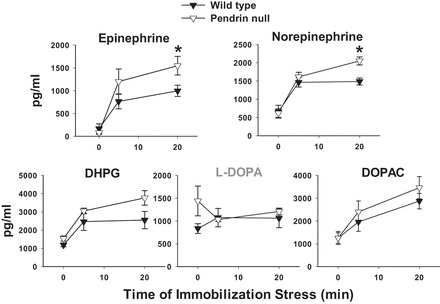Volume 309, September 2015
Lazo-Fernandez Y, Aguilera G, Pham TD, Park AY, Beierwaltes WH, Sutliff RL, Verlander JW, Pacak K, Osunkoya AO, Ellis CL, Kim YH, Shipley GL, Wynne BM, Hoover RS, Sen SK, Plotsky PM, Wall SM. Pendrin localizes to the adrenal medulla and modulates catecholamine release. Am J Physiol Endocrinol Metab 309: E534–E545, 2015. First published July 14, 2015; doi:10.1152/ajpendo.00035.2015; http://ajpendo.physiology.org/cgi/content/full/309/09/E534.
In Figure 1 (Fig. 8 in the article, p. E541) and its legend, data referred to as dopamine should instead read l-3,4-dihydroxyphenylalanine (l-DOPA). Similarly, the last sentence in results subsection Pendrin gene ablation increases stress-induced epinephrine and norepinephrine release (p. E539f) should read: Moreover, there were no differences between wild-type and pendrin-null mice in circulating l-3,4-dihydroxyphenylalanine (l-DOPA) or the dopamine metabolite 3,4-dihydroxyphenylacetic acid (DOPAC), either under basal conditions or following immobilization stress.
Fig. 1.



